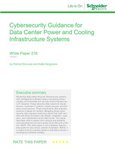It's a common refrain in information security; the question is not if cyber threats will strike but when. With the average cost of a data breach climbing to $4.45 million in 2023, cybersecurity is no longer just a technological concern but a financial imperative for businesses.
That's why ISO 27001 is so crucial. This leading international standard provides a comprehensive framework for managing information security risks. It offers a strategic approach to safeguarding critical assets, enabling your business to defend against cyber threats with clarity and efficiency. Doing so will give you peace of mind and the stability to achieve growth and success in today's business landscape.
In the data center world, the IT and OT systems are very closely linked, meaning that a cyber attack could get into the OT systems, and wreak havoc on this critical infrastructure. It takes little imagination to see how a cyber breach at a hospital's data center could quite literally have life-threatening consequences.
The most common threats to data centers include breaches of confidential information, Denial of Service (DoS) attacks, unauthorized access and use of computing resources, identity theft, or data theft.
Decoding ISO 27001
Unlike a checklist or guideline, ISO 27001 is an internationally recognized standard that outlines a systematic approach to managing cyber risks. Through a set of clearly defined controls, it helps businesses adopt an in-depth, organization-wide strategy.
The standard mandates assessing risks, cataloging information assets, and implementing controls to protect data. This process helps create an Information Security Management System (ISMS) to protect critical assets from cyberattacks.
ISO 27001 was first introduced in 2005 and underwent updates in 2013 and 2022 to keep pace with changes in the digital landscape. That means the 2022 version is uniquely positioned to tackle emerging cybersecurity challenges. It also restructures Annex A controls into more precise categories aligned with business operations.
The latest standard sets a new benchmark for cybersecurity. As the 2025 deadline to transition from the 2013 version approaches, now's the time to consider your existing defenses against digital threats.
That means a healthier cyber outlook. Implementing a powerful ISMS based on ISO 27001 can help you manage risks far more effectively, giving you the foundation to realize strategic advantages better.
Unlocking strategic benefits
More than just compliance, ISO 27001 offers a range of critical benefits. These include:
- Streamlining regulatory compliance: The ISO 27001 standard serves as a roadmap for businesses to fully align with information security regulations such as GDPR, HIPAA, CCPA, and CIRCIA. By following this framework, companies can avoid costly penalties and disruptions resulting from non-compliance.
- Driving operational efficiencies: ISO 27001 breaks down data silos and fortifies security measures, paving the way for an efficiency overhaul within the organization. Its guidelines ensure that information flows safely and securely across all functions, allowing businesses to run smoothly, with improved productivity and faster task completion.
- Earning stakeholder trust: In today's cyber-conscious landscape, an ISO 27001 certification instills added confidence among stakeholders, including customers, partners, and investors. This heightened trust can directly translate into a competitive edge, fostering increased customer loyalty and retention and swaying decision-makers to choose a certified organization over its non-certified counterparts. With data centers being the home of the Internet, it is essential that data center providers demonstrate their own security and safety measures.
By approaching compliance strategically, ISO 27001 is far more than a box-ticking exercise. When implemented thoughtfully, it improves efficiency and productivity in your organization while enhancing regulatory alignment and trust.
Integrating ISO 27001 into your business
To reap the rewards of ISO 27001, organizations must weave compliance into the fabric of their operations, so you should approach it strategically.
Here are a few ways you can do that:
- Align compliance with strategy: Ensure your ISO 27001 plans align with your overall business strategy. This approach gives you the best chance of success and ensures that compliance is foundational rather than a superficial layer.
- Communicate clearly: Establish strong communication channels to ensure that all employees, from interns to executives, understand their role in safeguarding data and why they can't afford to be negligent.
- Conduct regular training: Organize training and awareness programs to equip your workforce to recognize and head off security threats.
- Utilize a dedicated ISMS platform: The road to ISO 27001 compliance is typically relatively long. According to our research, businesses take 15.5 months on average to complete the process. A dedicated ISMS platform can significantly speed this journey up, giving you tools and templates to help assess risks, create compliance documents, train personnel, conduct audits, and more.
Paving the way for growth
Certifying your business to ISO 27001 is not merely about protecting it against cyber threats; it's about laying the groundwork for growth. You'll end up with confident stakeholders, high customer trust, more efficiency in your operations, and a competitive edge.
Building your business on solid foundations is crucial in today's cyber climate. Investing in ISO 27001 certification and workforce training will pay dividends in the long run.





